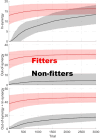Insights into the dependence of post-stroke motor recovery on the initial corticospinal tract connectivity from a computational model
- PMID: 39833900
- PMCID: PMC11749208
- DOI: 10.1186/s12984-024-01513-8
Insights into the dependence of post-stroke motor recovery on the initial corticospinal tract connectivity from a computational model
Abstract
There is a consensus that motor recovery post-stroke primarily depends on the degree of the initial connectivity of the ipsilesional corticospinal tract (CST). Indeed, if the residual CST connectivity is sufficient to convey motor commands, the neuromotor system continues to use the CST predominantly, and motor function recovers up to 80%. In contrast, if the residual CST connectivity is insufficient, hand/arm dexterity barely recovers, even as the phases of stroke progress. Instead, the functional upregulation of the reticulospinal tract (RST) often occurs. In this study, we construct a computational model that reproduces the dependence of post-stroke motor recovery on the initial CST connectivity. The model emulates biologically plausible evolutions of primary motor descending tracts, based on activity-dependent or use-dependent plasticity and the preferential use of more strongly connected neural circuits. The model replicates several elements of the empirical evidence presented by the Fugl-Meyer Assessment (FMA) subscores, which evaluate the capabilities for out-of-synergy and in-synergy movements. These capabilities presumably change differently depending on the degree of the initial CST connectivity post-stroke, providing insights into the interactive dynamics of the primary descending motor tracts. We discuss findings derived from the proposed model in relation to the well-known proportional recovery rule. This modeling study aims to present a way to differentiate individuals who can achieve 70 to 80% recovery in the chronic phase from those who cannot by examining the interactive evolution of out-of-synergy and in-synergy movement capabilities during the subacute phase, as assessed by the FMA.
Keywords: Corticospinal tract; Fugl-Meyer assessment; Reticulospinal tract; Stroke; Synergy.
© 2024. The Author(s).
Conflict of interest statement
Declarations. Ethics approval and consent to participate: The Human Research Protection Office at Washington University in St. Louis, MO approved this study and all participants provided written informed consent. Consent for publication: All authors agreed on this publication. Competing interests: The authors declare no competing interests.
Figures






Similar articles
-
The Strength of the Corticospinal Tract Not the Reticulospinal Tract Determines Upper-Limb Impairment Level and Capacity for Skill-Acquisition in the Sub-Acute Post-Stroke Period.Neurorehabil Neural Repair. 2021 Sep;35(9):812-822. doi: 10.1177/15459683211028243. Epub 2021 Jul 4. Neurorehabil Neural Repair. 2021. PMID: 34219510 Free PMC article.
-
Does Measurement of Corticospinal Tract Involvement Add Value to Clinical Behavioral Biomarkers in Predicting Motor Recovery after Stroke?Neural Plast. 2020 Nov 27;2020:8883839. doi: 10.1155/2020/8883839. eCollection 2020. Neural Plast. 2020. PMID: 33354207 Free PMC article.
-
Individual recovery profiles of manual dexterity, and relation to corticospinal lesion load and excitability after stroke -a longitudinal pilot study.Neurophysiol Clin. 2019 Apr;49(2):149-164. doi: 10.1016/j.neucli.2018.10.065. Epub 2018 Oct 31. Neurophysiol Clin. 2019. PMID: 30391148
-
The role of the corticospinal tract in motor recovery in patients with a stroke: a review.NeuroRehabilitation. 2009;24(3):285-90. doi: 10.3233/NRE-2009-0480. NeuroRehabilitation. 2009. PMID: 19458437 Review.
-
An overview of fractional anisotropy as a reliable quantitative measurement for the corticospinal tract (CST) integrity in correlation with a Fugl-Meyer assessment in stroke rehabilitation.J Phys Ther Sci. 2021 Jan;33(1):75-83. doi: 10.1589/jpts.33.75. Epub 2021 Jan 5. J Phys Ther Sci. 2021. PMID: 33519079 Free PMC article. Review.
References
MeSH terms
LinkOut - more resources
Full Text Sources
Medical

